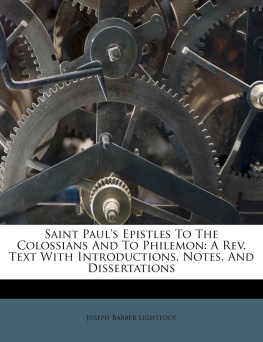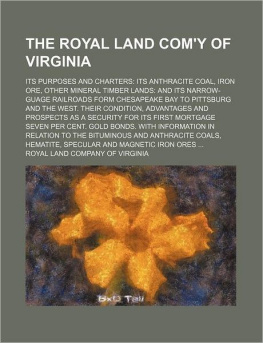Transcribers Note:
The original text includes annotations on two Greek texts, the Epistle to the Colossians, and an Epistle to Philemon. On each page, several lines of Greek are accompanied by a double column of notations on key words. It was not possible to follow that convention in this version, given the nature of our medium.
Any hyphenations in the Greek text that occurred on page breaks have been removed, and the word's end has been moved to the previous page. On many occasions, a note appears on an earlier page than the text it glosses. In this version, the notes have been arranged so that each follows the text to which it refers.
The Greek text appears in a larger font and has been fitted with and links which serve as next and previous buttons, which should aid in navigation across the pages as printed.
There are Greek inscriptions printed in an uncial font, and using a lunate sigma (). These will appear here as . The occasional blackletter font appears here as blackletter text .
Footnotes have been moved to follow the Index, and are resequenced to be unique across the text. Any internal references to those notes have been modified as well. Links are provided for ease of navigation.
The index includes references to both pages and to the verses of the two Epistles included here. Those references to a verse may refer to either the Greek itself, or to any of the notes on that verse.
The links provided in the Index will direct the reader to the page, or to the Greek verse itself. No attempt was made to link to the specific note.
Please consult the at the end of this text for any other issues that arose during its presentation.
THE EPISTLES OF ST PAUL.
III.
THE FIRST ROMAN CAPTIVITY.
EPISTLE TO THE COLOSSIANS.
EPISTLE TO PHILEMON.
Cambridge:
PRINTED BY C. J. CLAY, M.A.
AT THE UNIVERSITY PRESS.
ST PAULS
EPISTLES TO THE COLOSSIANS
AND TO
PHILEMON.
A REVISED TEXT
WITH
INTRODUCTIONS, NOTES, AND DISSERTATIONS.
BY
J. B. LIGHTFOOT, D.D.
CANON OF ST PAULS;
HULSEAN PROFESSOR OF DIVINITY,
AND
HONORARY FELLOW OF TRINITY COLLEGE, CAMBRIDGE.
London:
MACMILLAN AND CO.
1875.
[All Rights reserved.]
.
.
Clement.
Ignatius.
.
Polycarp.
PREFACE.
On the completion of another volume of my commentary, I wish again to renew my thanks for the assistance received from previous labourers in the same field. Such obligations must always be great; but it is not easy in a few words to apportion them fairly, and I shall not make the attempt. I have not consciously neglected any aid which might render this volume more complete; but at the same time I venture to hope that my previous commentaries have established my claim to be regarded as an independent worker, and in the present instance more especially I have found myself obliged to diverge widely from the treatment of my predecessors, and to draw largely from other materials than those which they have collected.
In the preface to a previous volume I expressed an intention of appending to my commentary on the Colossian Epistle an essay on Christianity and Gnosis. This intention has not been fulfilled in the letter; but the subject enters largely into the investigation of the Colossian heresy, where it receives as much attention as, at all events for the present, it seems to require. It will necessarily come under discussion again, when the Pastoral Epistles are taken in hand.
The question of the genuineness of the two epistles contained in this volume has been deliberately deferred. It could not be discussed with any advantage apart from the Epistle to the Ephesians, for the three letters are inseparably bound together. Meanwhile however the doctrinal and historical discussions will, if I mistake not, have furnished answers to the main objections which have been urged; while the commentary will have shown how thoroughly natural the language and thoughts are, if conceived as arising out of an immediate emergency. More especially it will have been made apparent that the Epistle to the Colossians hangs together as a whole, and that the phenomena are altogether adverse to any theory of interpolation such as that recently put forward by Professor Holtzmann.
In the commentary, as well as in the introduction, it has been a chief aim to illustrate and develope the theological conception of the Person of Christ, which underlies the Epistle to the Colossians. The Colossian heresy for instance owes its importance mainly to the fact that it throws out this conception into bolder relief. To this portion of the subject therefore I venture to direct special attention.
I cannot conclude without offering my thanks to Mr A. A. VanSittart who, as on former occasions, has given his aid in correcting the proof sheets of this volume; and to the Rev. J. J. Scott, of Trinity College, who has prepared the index. I wish also to express my obligations to Dr Schiller-Szinessy, of whose Talmudical learning I have freely availed myself in verifying Frankels quotations and in other ways. I should add however that he is not in any degree responsible for my conclusions and has not even seen what I have written.
Trinity College ,
April 30, 1875.
CONTENTS.
| EPISTLE TO THE COLOSSIANS. |
| INTRODUCTION. |
| PAGE |
| I. | The Churches of the Lycus |
| II. | The Colossian Heresy |
| On some points connected with the Essenes. |
| 1. The name Essene |
| 2. Origin and Affinities of the Essenes |
| 3. Essenism and Christianity |
| III. | Character and Contents of the Epistle |
| TEXT AND NOTES |
| On some Various Readings in the Epistle |
| On the meaning of |
| The Epistle from Laodicea |
| EPISTLE TO PHILEMON. |
| INTRODUCTION |
| TEXT AND NOTES |
| INDEX |
I.
THE CHURCHES OF THE LYCUS.
Situation of the three cities.
Lying in, or overhanging, the valley of the Lycus, a tributary of the Mander, were three neighbouring towns, Laodicea, Hierapolis, and Coloss from the point where the road between Laodicea and Hierapolis crosses the Lycus. Unlike Laodicea and Hierapolis, which overhang the valley on opposite sides, Coloss stands immediately on the river-bank, the two parts of the town being divided by the stream. The three cities lie so near to each other, that it would be quite possible to visit them all in the course of a single day.






